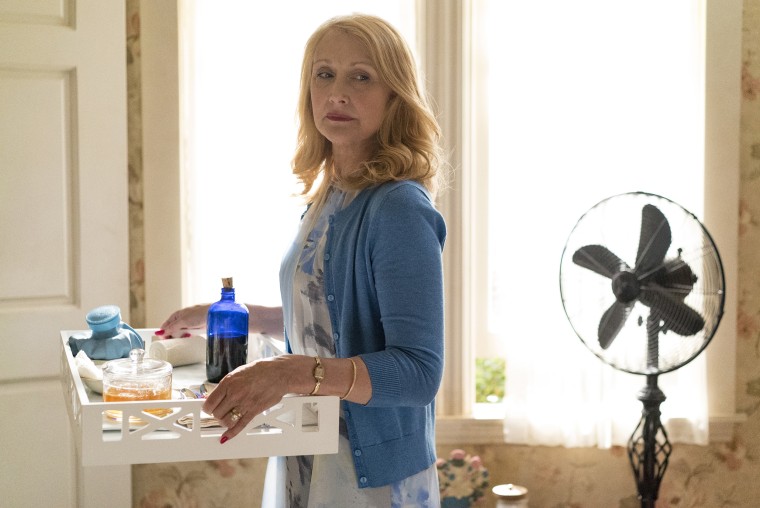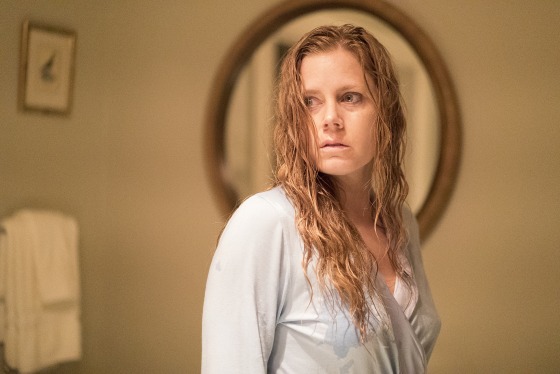Spoilers below.
“Sharp Objects,” HBO’s latest standalone miniseries offering, ended its eight-week run over the weekend. Based on the debut book by Gillian Flynn (author of suspense novels like “Gone Girl”), the show has been a weekly tour de force for A-list actress Amy Adams, who plays Camille Preaker, a journalist sent back to her hometown to write human interest stories about the grisly murders of two teenage girls. Part of the finale’s corkscrew of twists reveals Camille’s mother, Adora Crellin (played by Patricia Clarkson), to be a murderer. “She was guilty of a very female sort of rage,” says Camille in the final episode. This line sums up the show’s theme nicely.
The series offers a different perspective on female rage than what we’ve seen before, however. Notably, men are neither the perpetrators nor the triggers of the violence in “Sharp Objects.” If anything, men are passive, meek, and slaves to their own emotions. At best, they exist to be the story’s deus ex machina, swooping in to save the day before returning to the background. At worst, they are complicit, turning a blind eye to the horror being perpetrated right in front of them by generations of women.
“She was guilty of a very female sort of rage,” says Camille in the final episode. This line sums up the show’s theme nicely.
Unfortunately, when it comes to the ending, the show pulled its final punch, truncating Flynn’s original ending. When it came time to reveal that the murder was committed not just by a woman, but by a young girl, with her two best friends as accomplices, the show chose not to delve into the motives, the psychology, or the consequences. Instead it glamorized the killings in a slick credits sequence, leaving the audience bereft of understanding how the rage of women can produce an outcome like this.
“Sharp Objects” has been presented as this year’s answer to HBO’s 2017 hit “Big Little Lies,” another miniseries mystery based on another suspense novel written by a woman, Liane Moriarty. On the surface, both these shows are similar; “Sharp Objects” even looks a little like “Big Little Lies.” Director Jean-Marc Vallée helmed both, and there are times when the two series could be mistaken for half-sisters. But “Big Little Lies” is a show about sisterhood and how women protect their own against the violence men inflict upon them. Men are the monsters, the abusers, the ones who trap these characters into their positions in life. “Sharp Objects” has no need for men in these roles. It posits that sisterhood is a lie.
The show begins with the murders of two 13-year-old girls. When Camille arrives in her tiny hometown of Wind Gap, she finds herself informed by both lead investigators — local police chief Vickery and the big city detective Willis — that only a man could be capable of the violence (strangulation, teeth pulling) that has taken place. Men are also assumed by everyone to be in charge of this investigation, with Camille outwardly performing the trope of the inept and ethics-free female journalist. But in reality, the cops are merely foils. This is really a story all about repressed women, and the different ways their emotions manifest.
While the murders may be the catalyst for the series, the real drama happens inside Camille’s childhood home, the big plantation on the hill, where her mother reigns over the town as the daughter of the wealthiest family and biggest employer in the area. Adora, the aging matriarch of the family, subsumes the rejection she experienced as a child by her parents by performing an exaggerated form of femininity and motherhood. She is also a narcissist, so obsessed with how she appears to others that she’s developed what used to be known as Munchausen Syndrome By Proxy. (Today it’s more often referred to as Factitious Disorder Imposed on Another, or FDIA.) She spends her life poisoning her children, in order to be the virtuous martyr figure.

Adora and Camille have a contentious relationship partly because Camille literally would not take her medicine. Adora had her eldest daughter out of wedlock, and the now 30-something has spent her life turning her rage against her mother inward. Camille has a drinking problem, an addiction to self-injury — she literally carves words into her body — and an intimacy problem. Amma (Eliza Scanlen), Camille’s half-sister who is almost 20 years her junior, represents the family’s final generation. And unlike her sisters and mother, she turns her rage explicitly outward where it curdles into homicide.
In Flynn’s book, Amma kills three people. But here’s where HBO’s showrunners flinched. “Sharp Objects” was fine with showing women hurting themselves both outwardly and inwardly, or poisoning each other quietly, lustfully indulging in the horror of these different forms of harm. It is also happy to wallow in the tension that comes from living with an abusive parent. And Adams, Clarkson and relative newcomer Scanlen are magnificent in the scenes where they turn on each other.
But the show just couldn’t bring itself to explore the idea that a teenage girl could murder her peers. Like the men in the series, it could not fathom the reality of a female serial killer, and so rather than dwell on such a non-mainstream ending, it cut to black before alluding to the truth during the credits. No wonder the creators of the show have promised there will be no sequel.
“Sharp Objects” does allow some of the novel’s final, horrifying elements to come through. Camille discovers evidence Amma is at least somehow connected to the murders when she realizes her kid sister’s “ivory” dollhouse floor is actually paved with the teeth of the victims. But the final piece of evidence is never discussed. The show does not explore what sort of twisted fury would turn a child into a serial killer, or the psychotic break Camille suffers upon learning the truth. Instead it allows a more conventional ending, one where no one will ever know if Amma will be punished for her crimes, or how she accomplished it. “Shhh, don’t tell mama,” whispers Amma. She’d probably be disappointed.
Ani Bundel has been blogging professionally since 2010. Regular bylines can be found at Elite Daily, WETA's TellyVisions, and Ani-Izzy.com.

